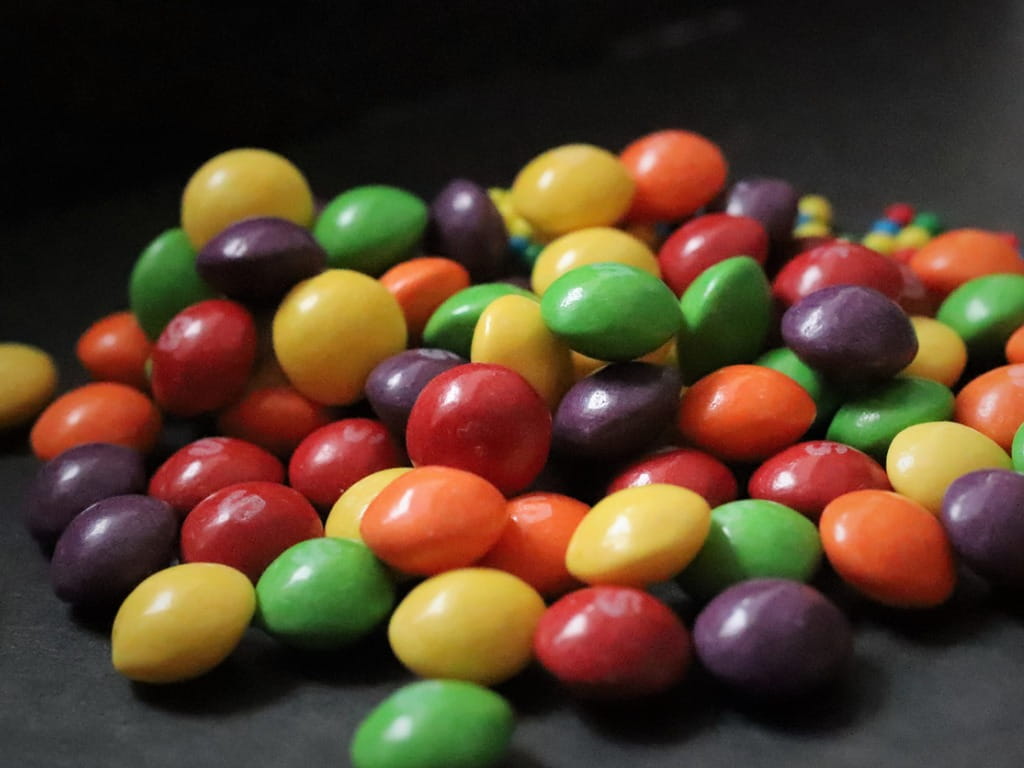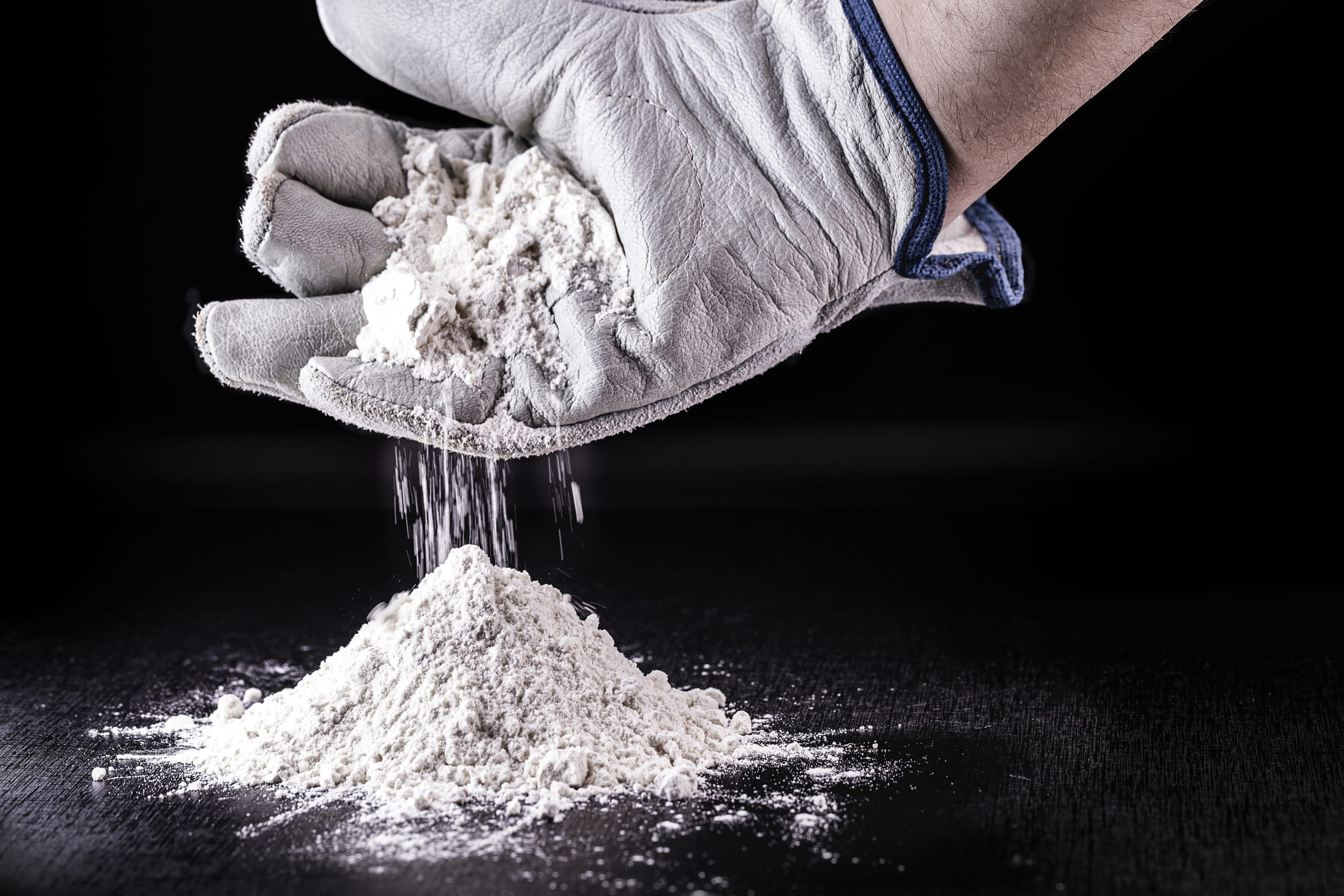Are Skittles safe to eat?

The Bottom Line
Skittles contain titanium dioxide, a chemical used as a whitening agent in foods. Titanium dioxide is associated with cancer development after inhalational exposures, and it may have effects on DNA and gastrointestinal system function.

What is titanium dioxide?
Titanium is a common element found in the earth’s crust. In nature, titanium occurs in two forms: titanium oxide or titanium dioxide. While titanium dioxide is found in nature as a mineral, it can also be manufactured commercially. Titanium dioxide is often used as a pigment or dye because it has a bright white color, does not break down easily when exposed to ultraviolet light, and remains stable over time. Because smaller titanium dioxide particles scatter light more effectively, they are often used for whitening purposes. Some of the smallest titanium dioxide particles are less than 100 nanometers in size and are called “nanoparticles”.
What is titanium dioxide used for?
Approximately 70-80% of titanium dioxide produced worldwide is used for pigmentation in paint, but titanium dioxide is also used as a whitening agent in foods, including coffee creamer, frosting or icing, chewing gum, and lemonade. It is an ingredient in some pharmaceutical products, cosmetics, toothpastes, plastics, and paper. Like zinc oxide, titanium dioxide is a common ingredient of mineral-type sunscreens, which are sunscreens where the mineral ingredients physically block UV radiation. Titanium dioxide can also be used as a flavor enhancer and can be found in soups, mustard, beer, and wine. “Food-grade” titanium dioxide is often referred to be the abbreviation “E171” and contains up to 40% titanium dioxide nanoparticles. The United States Food and Drug Administration allows titanium dioxide to be used as a food color additive, as long as the amount does not exceed 1% of the food’s weight.What happens to titanium dioxide in the body?
When humans eat titanium dioxide, less than one-tenth of one percent of the consumed product is actually absorbed by the body. This means that titanium dioxide does not cross into the bloodstream in significant amounts. Instead, consumed titanium dioxide travels through the gastrointestinal tract and is excreted through the feces.Is titanium dioxide safe?
Because exposures to titanium dioxide pass through the gastrointestinal system, scientists have explored whether titanium dioxide can cause unwanted gastrointestinal side effects. There are few studies concerning the safety of titanium dioxide in the body, and most of these studies have involved animals other than humans. In one study involving mice, titanium dioxide consumption caused an increased number of inflammatory cells in the intestines. In another mouse study, ingestion of food-grade titanium dioxide was associated with increased colorectal tumor formation as well as genetic changes that could be related to cancer growth. Because of their very small size, nanoparticles are believed to create more toxic effects in the human body than larger particles. Titanium dioxide nanoparticles may cause increased cellular changes, DNA damage, and inflammation compared with larger-sized titanium dioxide particles, but more research is needed to define the true damage caused by titanium dioxide nanoparticles in humans.Can Skittles cause cancer?
Inhalation of ultra-fine titanium dioxide particles, as well as pigment-grade titanium dioxide, is associated with cancer development in rats, mice, and hamsters. Because of this, titanium dioxide is considered possibly carcinogenic to humans after inhalational exposure. People who work in industrial settings where titanium dioxide is produced may be at increased risk for cancer development, although the exact relationship between titanium dioxide inhalation and cancer in humans remains unclear. While inhalation of titanium dioxide may increase the risk of cancer in some individuals, there is no evidence that eating Skittles is associated with cancer development in humans.Is titanium dioxide banned in Europe?
In 2021, the European Union prohibited the use of food-grade titanium dioxide (E171) as a food additive. This ban takes full effect in August 2022 and was based on evidence suggesting that titanium dioxide can affect inflammation and cause genetic damage.Why is the maker of Skittles being sued?
In July 2022, a California resident filed a lawsuit against Mars, the manufacturer of Skittles. The lawsuit alleges that Skittles candies, which contain titanium dioxide, are “unfit for human consumption” due to the presence of the chemical.What should I do if I get sick after eating Skittles?
If you experience adverse or unexpected symptoms from Skittles, get guidance from Poison Control. Get an immediate personalized recommendation online or call 1-800-222-1222. Both options are free, confidential, and available 24 hours a day.
Kelly Johnson-Arbor, MD
Medical Toxicologist
For media inquiries, please contact Krista Osterthaler at osterthaler@poison.org.
Poisoned?
Call 1-800-222-1222 or
Prevention Tips
- Read food labels carefully to understand the ingredients that are present.
- Eat a healthy and balanced diet every day, including fruits, vegetables, dairy, and protein.
- Talk to your doctor if you are exposed to titanium dioxide dust particles on a regular basis at work.
This Really Happened
Nine adult volunteers participated in a study of the effects of titanium dioxide on the human body. The study subjects each consumed single oral doses of titanium dioxide particles of different sizes, mixed in water. No adverse effects were noted in any of the study subjects. Blood testing showed that very little titanium dioxide was absorbed from the gastrointestinal tract.For More Information
Skittles ‘unfit for human consumption,’ California lawsuit claims - Los Angeles Times (July 18, 2022)
Titanium dioxide: E171 no longer considered safe when used as a food additive - European Food Safety Authority (May 6, 2021)
References
Baan R, Straif K, Grosse Y, Secretan B, El Ghissassi F, Cogliano V; WHO International Agency for Research on Cancer Monograph Working Group. Carcinogenicity of carbon black, titanium dioxide, and talc. Lancet Oncol. 2006 Apr;7(4):295-6.Bischoff NS, de Kok TM, Sijm DTHM, van Breda SG, Briedé JJ, Castenmiller JJM, Opperhuizen A, Chirino YI, Dirven H, Gott D, Houdeau E, Oomen AG, Poulsen M, Rogler G, van Loveren H. Possible Adverse Effects of Food Additive E171 (Titanium Dioxide) Related to Particle Specific Human Toxicity, Including the Immune System. Int J Mol Sci. 2020 Dec 28;22(1):207.
Bischoff NS, Proquin H, Jetten MJ, Schrooders Y, Jonkhout MCM, Briedé JJ, van Breda SG, Jennen DGJ, Medina-Reyes EI, Delgado-Buenrostro NL, Chirino YI, van Loveren H, de Kok TM. The Effects of the Food Additive Titanium Dioxide (E171) on Tumor Formation and Gene Expression in the Colon of a Transgenic Mouse Model for Colorectal Cancer. Nanomaterials (Basel). 2022 Apr 7;12(8):1256.
EFSA Panel on Food Additives and Flavourings (FAF), Younes M, Aquilina G, Castle L, Engel KH, Fowler P, Frutos Fernandez MJ, Fürst P, Gundert-Remy U, Gürtler R, Husøy T, Manco M, Mennes W, Moldeus P, Passamonti S, Shah R, Waalkens-Berendsen I, Wölfle D, Corsini E, Cubadda F, De Groot D, FitzGerald R, Gunnare S, Gutleb AC, Mast J, Mortensen A, Oomen A, Piersma A, Plichta V, Ulbrich B, Van Loveren H, Benford D, Bignami M, Bolognesi C, Crebelli R, Dusinska M, Marcon F, Nielsen E, Schlatter J, Vleminckx C, Barmaz S, Carfí M, Civitella C, Giarola A, Rincon AM, Serafimova R, Smeraldi C, Tarazona J, Tard A, Wright M. Safety assessment of titanium dioxide (E171) as a food additive. EFSA J. 2021 May 6;19(5):e06585.
Iavicoli I, Leso V, Fontana L, Bergamaschi A. Toxicological effects of titanium dioxide nanoparticles: a review of in vitro mammalian studies. Eur Rev Med Pharmacol Sci. 2011 May;15(5):481-508.
Jones K, Morton J, Smith I, Jurkschat K, Harding AH, Evans G. Human in vivo and in vitro studies on gastrointestinal absorption of titanium dioxide nanoparticles. Toxicol Lett. 2015 Mar 4;233(2):95-101.
Nogueira CM, de Azevedo WM, Dagli ML, Toma SH, Leite AZ, Lordello ML, Nishitokukado I, Ortiz-Agostinho CL, Duarte MI, Ferreira MA, Sipahi AM. Titanium dioxide induced inflammation in the small intestine. World J Gastroenterol. 2012 Sep 14;18(34):4729-35.
Peters RJB, Bouwmeester H, Gottardo S, Amenta BV, Arena M, Brandhoff P, Marvin HJP, Mech A, Botelho Moniz F, Quiros Pesudo L, Rauscher H, Schoojnhans R, Undas AK, Vettori MV, Weigel S, Aschberger K. Nanomaterials for products and application in agriculture, feed and food. Trends Food Sci Technol. 2016;54:155-164.
Putra C, Bello D, Tucker KL, Kelleher SL, Mangano KM. Estimation of Titanium Dioxide Intake by Diet and Stool Assessment among US Healthy Adults. J Nutr. 2022 Jun 9;152(6):1525-1537.
Racovita AD. Titanium Dioxide: Structure, Impact, and Toxicity. Int J Environ Res Public Health. 2022 May 6;19(9):5681.
The Washington Post. Skittles lawsuit claims “toxin” makes them “unfit for human consumption”. Available at https://www.washingtonpost.com/food/2022/07/18/skittles-lawsuit-toxin-titanium-dioxide/. Accessed 7.19.22.
United States Food and Drug Administration. CFR- Code of Federal Regulations, Title 21. Available at https://www.accessdata.fda.gov/scripts/cdrh/cfdocs/cfcfr/cfrsearch.cfm?fr=73.575. Accessed 7.19.22.
USDA Foreign Agricultural Service. European Union: titanium dioxide banned as a food additive in the EU. Available at https://www.fas.usda.gov/data/european-union-titanium-dioxide-banned-food-additive-eu. Accessed 7.19.22.
Weir A, Westerhoff P, Fabricius L, Hristovski K, von Goetz N. Titanium dioxide nanoparticles in food and personal care products. Environ Sci Technol. 2012 Feb 21;46(4):2242-50.
Poisoned?
Call 1-800-222-1222 or
Prevention Tips
- Read food labels carefully to understand the ingredients that are present.
- Eat a healthy and balanced diet every day, including fruits, vegetables, dairy, and protein.
- Talk to your doctor if you are exposed to titanium dioxide dust particles on a regular basis at work.
